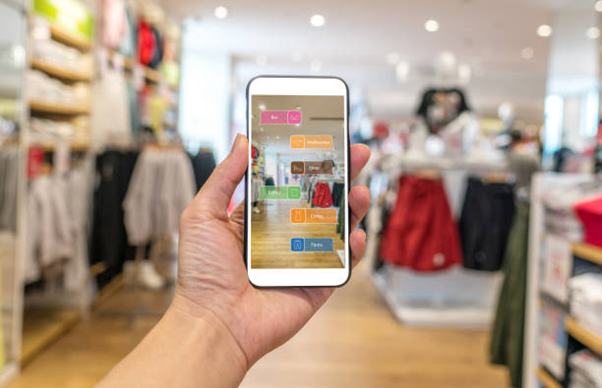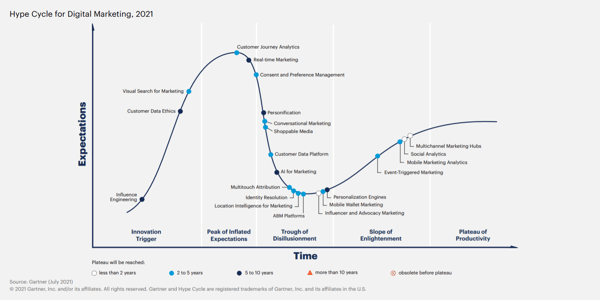"Oh, another one of these terms", I hear you say. "What about the mega-space, or the augmented funnel forest. Or even the virtual reality hybrid tornado." Well, trust us on this one. It's pretty cool.

But first up. What even is the AR cloud? And is it as magical as it sounds? Let's find out.
What is the AR cloud?
The AR cloud, or 'augmented reality cloud' is a real-time 3D map overlaid onto the real world. You remember Pokémon Go, right? Think of that, on a worldwide, continuous scale.
The founder of AWE, Onri Inbaar, came up with the term to describe the digital 3D copy of the real world. The purpose of the cloud is to enable the continuous sharing of augmented reality experiences across places and devices.
It will provide data and services related to the surroundings of the individual user. So, consider a person going into a shoe shop.
They'll be able to see the reviews of each product, the names of the employees, how many of their size is in stock, maybe even adverts for the products themselves - all through their AR device. So, that might be a phone in the near- future, and glasses in the future-future. Or as Scott Galloway suggested in his latest podcast, may even be through audio devices like air pods.

In fact, the Augmented Reality market is valued to be worth between $70B, growing to $75B in 2023. This is compared to the highly-praised and more highly-covered VR space, which is worth $10B in comparison.
Basically, AR cloud innovation allows for the collaboration of the physical and virtual/digital world, in order to develop vivid encounters. Every interaction can be give additional, digitally-sourced context to people, places, and things, So, customers can be given pieces of information of their immediate environment.
According to ABI research: "The Augmented Reality (AR) cloud is often described as the world’s digital twin, a digital copy of the real world that is accessible by any user from any device, from any location and at any time.
It is expected that the AR cloud will play catalytic role in the way that users engage and search for information while at the same time, transform the way that businesses operate and communicate with customers and employees in both physical and digital forms."

In fact, the firm suggests that the AR cloud has the potential to effect the value chain of AR, forecasting that the space will reach the $102B mark by 2024.
And with tech advancements like LiDAR, the AR cloud has become feasible. LiDAR, or Light Detection and Ranging, is a method of measuring distance using light, in the form of a pulsed laser.
Modern smartphones such as the iPhone 12 have already began to support this tech. Plus, it takes advantage of existing tech like mobile technology, 5G telecommunication services and Edge computing.
Gartner predicts that by 2025, 15% of $1B+ revenue organisations will use the AR cloud, in order to shake up the way their customers interact with the physical world. So, though the tech might not be immediately happening, businesses can take steps to prepare.
Think being left behind in the advent of the internet age. Businesses that adopted websites and other internet tech did so for many different reasons, but found themselves on the right footing to enter the new space.
“The journey toward scaled deployment of the AR Cloud has begun and numerous companies from tech giants to start-ups are starting to build ‘mini AR clouds’ and contributing to building a cloud-based 3D map of the real world.
The synergy of numerous technologies, including computer vision, Simultaneous Localization and Mapping (SLAM), and connectivity are required to precisely localize devices in the environment and deliver sharable and persistent AR content,”
- Eleftheria Kouri, Research Analyst at ABI Research.
So, it's all about keeping an eye on the tech, to keep up with the tech space. According to Onri Inbaar, you need a couple of pieces in order to run an AR cloud - tech that is worth investing in for this new, digital, meta-verse age:
- A scalable, shareable point cloud that understands the geometry and shapes of the real world
- An instant, extensive localiser that works from any angle, and on multiple devices
- Real-time multi-user interaction - that works for all users, even if they're remote.
This all benefits the customer experience of your prospects. Instead of using their phone to trek through a bunch of websites or social pages in order to get a good view of your business, instead they can see all the reviews, information, and content, they need using their glasses and a voice assistant.
So, by the time they make a purchase in a store, or on the site, they've been treated to a bunch of integrated technologies and services which have empowered them with the best experience possible. This huge, overarching AR experience is the basic concept behind the AR cloud.
Now, only a few years ago, all this would've been unfathomable. But with a certain global world-shifting pandemic, the need for digital and AR solutions has become way more urgent. In fact, it's made jobs, interactions, and purchasing safer, faster and easier. So, the demonstration of business value is there.

Companies like Magic Leap have even developed their own custom versions. The 'Magicverse' allows the company to market various unique features and approaches.
The Limitations of Current AR tech
All of this remains limited due to a few key reasons:
- Usability. Quite a lot of the current AR devices fall short in terms of usability. Current AR tech relies on smartphones, which aren't made for continuous, uninterrupted use.
This is what makes the AR cloud great - being able to access information at all times. So if the customer decides getting out their phone is too much effort, that CX is ruined. And head-mounted displays are a little far off.
Due to cost, ergonomics, and generally ugliness, people aren't warming to them. This may change with the introduction of the Apple Glass in 2023 - a lightweight, wearable technology fit with the most up-to-date AR capabilities - Apple's "rings". These "rings" are designed specially for tracking finger and hand movements, and could improve the capabilities of the product. - Maturity. Many technologies that are needed to enable all the stuff that makes the AR work is still maturing. So, 5G, Edge, AI and IoT all need a little bit more time before it can allow for the smoothness the cloud needs.
- Infrastructure. Basically, the underlying infrastructure needed to allow for good AR experience i.e. persistent and collaborative, just isn't there yet. In fact many AR experiences are purpose built, separate and siloed.
How it All Works
Well, let's have a look to see how some names are using the tech already.
Google. One of the most advanced AR cloud-based apps out there at the moment is Google's AR navigation. This leverages Google's Visual Positioning Service, and the AR cloud, in order to enable device localisation.
Sturfee. Sturfee uses this Visual Positioning Service and AR cloud for AR city navigation.
6D.ai. This company is a good example of indoor navigation leveraging the AR cloud.
Matt Miesnieks, CEO of 6D.ai, suggests that:
“Being able to communicate digitally in 3D and in context, in situ, with the real world around us – this is a richer type of communication that has never been possible before. The AR Cloud enables users to find specific locations with an accuracy of millimetres, both indoors and outdoors. Suddenly, the world is more easily and intuitively navigable.”
Potential Use Cases
- The internet of places
This collection of tech, including geo-location and computer vision, will basically make the world completely digitally interactive and 'clickable'. All of this will be woven in together by a visual browser and a system of filters.
- Collaborative Shopping experiences
Cathy Hackl is a Futurist (VR & AR) at You Are Here Labs. She describes how collaborative shopping experiences can be immediately useful:
“In the next few years, we will see multiplayer/collaborative AR impact the at-home shopping experience with v-commerce, as well as the in-store and in-shelf shopping experience in brick and mortar retail. All of which will be shared via social media platforms.”
This move the AR cloud away from the single-player perception we've been working with for a few years.
- Virtual Assistance
Since working remotely and well, remote everything, has become more common, so will virtual assistance. Advanced augmented reality technologies enable customers to communicate with professionals virtual at any time of the day. WebRTC uses AR tech to provide remote assistance from IT professionals, even.
- Hiring and Training
Already job-seekers can attend a virtual job fair, using advanced AR technology. Plus virtual onboarding has become pretty common over the pandemic period. The extended context that the AR cloud provides would be infinitely useful in these scenarios.
- Facial Tracking
Advanced AR can be used to track the human eye and facial expressions. So, it can be used to see how people react to a product or experience, offline and on. Creepy, but useful.
- Gamification
The gaming industry has been the most receptive to AR and VR technologies, and as a result has seen the most advancements. The aforementioned Pokémon Go app alone uses GPS, compass, and beacons. But gamification can also be extremely popular in marketing - adding interactivity and engagement can up customer experience immensely.


